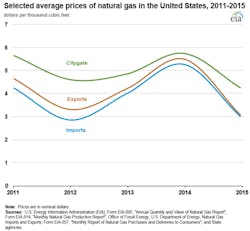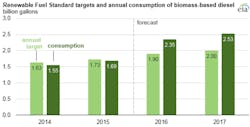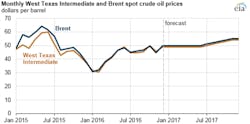Obama blocks offshore drilling in US Arctic and Atlantic
President Barack Obama moved to indefinitely block new offshore drilling rights in much of the U.S. Arctic and parts of the Atlantic by invoking a provision in the 1953 Outer Continental Shelf Lands Act. The provision allows presidents to remove any currently unleased lands in the Outer Continental Shelf from future oil and gas leasing. The announcement was coordinated with similar action by Canadian Prime Minister Justin Trudeau to prevent drilling in large areas of the Arctic.
The oil industry is expected to press President-Elect Donald Trump to overturn the order when he takes office. But the statute does not include a provision to reverse it and efforts to do so could get tied up in court for much of Trump’s four-year term. Environmental groups have argued that offshore drilling threatens lucrative coastal tourism and the fishing industry.
Quarterly upstream earnings positive for the first time since 2014
Oil production companies recorded positive earnings from their upstream (exploration and production) operations in the third quarter of 2016 for the first time since the fourth quarter of 2014, according to the U.S. Energy Information Association (EIA). Recently released earnings statements from 102 global oil companies show aggregate earnings from upstream operations totaled almost $4.8 billion. Even though this is considerably lower compared with earnings from 2011 to 2014, earnings recovered from significant losses that occurred throughout 2015 and the first half of 2016 (Figure 1). Oil companies have recently increased price hedging activity that, along with higher earnings, could suggest companies are reducing price risk with plans to increase investment and future production.
Oil and gas companies to turn cash flow positive in 2017
If OPEC production cuts drive oil prices above $55 per barrel, the oil and gas industry is expected to turn cash flow positive for the first time since the downturn, according to International analyst firm Wood Mackenzie’s global corporate outlook for 2017.
Strengthening finances will still be a top priority for oil companies in 2017, according to the company. Capital discipline, cost reduction and deleveraging will frame corporate strategies in 2017. But 2016 will prove to be the low point in the investment cycle, with confidence boosted by OPEC’s decision to cut production.
Graphic courtesy of the EIA
US natural gas production resilient to market changes in 2015, but has fallen in 2016
U.S. dry natural gas production continued to increase in 2015, reaching 74.1 billion cubic feet per day (Bcf/d). This record-high level was a 4.5 percent (3.2 Bcf/d) increase over 2014, according to EIA’s Natural Gas Annual, which provides final production data for 2015. The increase in 2015 production levels marked the tenth straight annual increase, with the most recent increase occurring despite natural gas prices at the Louisiana Henry Hub declining more than 40% from an average of $4.55 per million British thermal unit (MMBtu) in 2014 to $2.62/MMBtu in 2015.
US oil and natural gas proved reserves declined in 2015 because of lower prices
U.S. crude oil proved reserves declined 4.7 billion barrels (11.8 percent) from their year-end 2014 levels to 35.2 billion barrels at year-end 2015, according to EIA’s recently released U.S. Crude Oil and Natural Gas Proved Reserves report. U.S. natural gas proved reserves decreased 64.5 trillion cubic feet (Tcf), a 16.6 percent decline, reducing the U.S. total to 324.3 Tcf at year-end 2015.
Graphic courtesy of the EIA
EIA forecasts continued biomass-based diesel growth with final 2017 RFS targets
On Nov. 23, the U.S. Environmental Protection Agency (EPA) issued its final rule for the 2017 Renewable Fuel Standard (RFS) program year, with higher targets than those initially proposed in May. The EPA increased both the advanced biofuels and total renewable fuel targets while keeping the cellulosic biofuel and biomass-based diesel targets unchanged, the EIA announced.
EIA used the 2017 RFS targets in the final rule in developing the U.S. biofuels forecast through 2017 for the latest Short-Term Energy Outlook. The administration expects that the rule will have the greatest impact on biomass-based diesel consumption, which is forecast to continue its recent growth into 2017, while ethanol consumption remains largely unchanged.
Graphic courtesy of the EIA
Recent OPEC agreement reflected in EIA forecast
In the EIA’s December Short-Term Energy Outlook (STEO), the West Texas Intermediate (WTI) and Brent crude oil 2017 price forecasts increased by about $1 per barrel (b) from the November STEO, with prices expected to average $51/b and $52/b, respectively. The WTI price is forecast to average $49/b in the first half of 2017 and end the year at $54/b, while the Brent price is forecast to average $50/b in the first half of 2017 and end the year at $55/b. The forecast includes consideration of the Organization of the Petroleum Exporting Countries’ (OPEC) recent announcement to reduce production. However, the agreement only resulted in small changes to the STEO forecast.
At the Nov. 30 OPEC meeting, member countries agreed to reduce production by approximately 1.2 million barrels per day (b/d) from an October baseline and to lower OPEC’s production ceiling to 32.5 million b/d beginning Jan. 1, 2017. The agreement is meant to last six months with an option to extend for an additional six months.
The EIA adjusted the December STEO by reducing OPEC’s crude oil production by 100,000 b/d in the first quarter of 2017 to 32.8 million b/d. The difference between OPEC’s and EIA’s production estimates reflects, in part, differences in production in Indonesia, Libya, and Nigeria, which are not participating in the agreement. OPEC’s agreed-upon output levels for early 2017 were similar to EIA’s November STEO forecast, and already included some expectation of slower production growth in 2017.
Tennessee Gas Pipeline will abandon 1 of 4 natural gas lines
On Dec. 2, the Federal Energy Regulatory Commission‘s (FERC) 30-day public comment period concluded on Kinder Morgan affiliate Tennessee Gas Pipeline’s (TGP) proposal to abandon natural gas service on one of their four lines that runs from the U.S. Gulf Coast to the Northeast and replace it with expansion in capacity on the remaining three lines. FERC has set Jan. 31, 2017, as the Federal Authorization Decision Deadline to issue the final order. Current northbound natural gas flows on TGP have fallen as production in the Northeast has grown, with some segments now moving natural gas both north and south.
Once TGP receives the final order and completes work approved in the order, the company intends to sell the abandoned 964-mile pipeline to another Kinder Morgan affiliate, Utica Marcellus Texas Pipeline (UMTP), which intends to upgrade and convert the line to carry natural gas plant liquids south from the Marcellus/Utica production region to the Gulf Coast. UMTP plans to construct approximately 200 miles of new pipe to reach the Mont Belvieu hub and to build at least three new lateral pipelines in the Northeast to connect to natural gas processing plants and fractionators.





